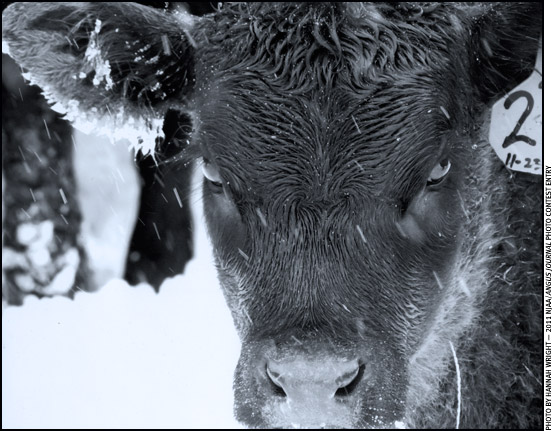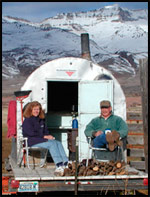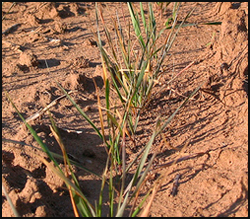MANAGEMENT...

Cold-Weather Calving Tips
What tactics — and tricks of the trade — make calving season run more smoothly and get calves off to a healthy start? You likely have some tried-and-true management practices of your own, but here, two Angus breeders share a few of theirs. Read more.

Ron Torell with his wife, Jackie
Cow Camp Chatter
Ron Torell shares tips on developing calves for California grass.
Earlier this year, Nevada livestock producers traveled to northern California to examine marketing alternatives for their cattle and learn about California grass. Nevada is an exporter of lightweight calves, primarily due to the unavailability of standing winter feed, which results in an inability to economically add weight and value to calves during the snow-bound months. Fortunately for Nevada livestock producers, California offers an abundance of wintertime grass, making them importers of lightweight calves.
According to Ellington Peek, owner and operator of Shasta Livestock Auction Yard and Western Video Market in Cottonwood, Calif., the northern California grazing season begins in mid-November and extends through mid-May. Ranches are stocked at a rate of 2.7 to 6.0 acres per five-weight calf for the season. The typical gain for the six-month period will range from 200 to 300 pounds (lb.), with the heifer calves gaining approximately 25 lb. less than a steer. Read more.
Targeted Grazing
Grazing research could influence wildfire management strategies.
According to New Mexico State University rangeland expert Derek Bailey, overgrazing and 20th century fire-suppression strategies have laid the groundwork for some of today's "catastrophic" wildfires. In some areas, the grasses that fueled normal and periodic low-intensity surface fires in the past have been replaced by densely packed trees and brush that fuel the raging prairie and forest fires seen in recent years, including record-setting 2011 fires in the Southwest.
Bailey is a professor in the Department of Animal and Range Sciences and the director of NMSU's Chihuahuan Desert Rangeland Research Center north of Las Cruces. He and other investigators are halfway through a three-year study that, among other things, is investigating the possibility that implementing a targeted grazing strategy for range cattle can significantly reduce the risk of catastrophic wildfires in certain ecosystems. Read more.

Kris Ringwall
Beef Talk
2011 production benchmarks are available.
The beef business is a long-term business, so producers need to gauge their production against solid indicators that can help them set or modify production goals.
Once again, the North Dakota Beef Cattle Improvement Association (NDBCIA) is pleased to summarize the average performance of beef cattle herds that are utilizing the Cow Herd Appraisal Performance Software (CHAPS) program. The NDBCIA has been keeping records since 1963 and presents these annual evaluations as five-year rolling benchmark values for average herd performance for several traits. Although the individual year averages are good, the concept of a rolling five-year average provides a firmer benchmark because it buffers quick jumps or slumps in the data. Read more.
 Root of the Problem
Root of the Problem
Poor wheat tillering, root development may be due to aluminum toxicity.
If wheat growth and vigor is poor this fall, one possible cause is aluminum toxicity associated with low-pH soils, says Dorivar Ruiz Diaz, Kansas State University (K-State) Research and Extension nutrient management specialist.
Aluminum toxicity begins to occur where soil pH levels are less than 5.0 and potassium chloride-extractable free aluminum levels are greater than 25 parts per million (ppm), Ruiz Diaz says. Some varieties of wheat, such as Everest and Overley, have better tolerance to low-pH soils and high aluminum levels than other varieties, such as Fuller. Read more.
New Products
Industry affiliates provide a wide array of products and services to assist you on the farm and ranch. Here's an assortment of new products to hit the market recently.
Beware of Hitchhikers
AgriLife Extension expert says expect weed growth after drought, wildfires.
"A weed is simply a plant growing out of place or growing in a site where it is not desired," says Barron Rector, Texas AgriLife Extension Service range specialist. He warns that following this year's drought, wildfires and tons of imported hay, there may be a lot more weeds for landowners to deal with, and some could be invasive species or even toxic.
"The soundest way to control weeds is to prevent the invasion, which means we must understand the biology, limit the movement, understand the human behavior and actions that can cause the spread, and understand the pathways for its introduction," he said. Read more.
Angus Advisor
Click here for November management tips from cattle experts across the nation. Advice separated by region.
[Click here to go to the top of the page.]










